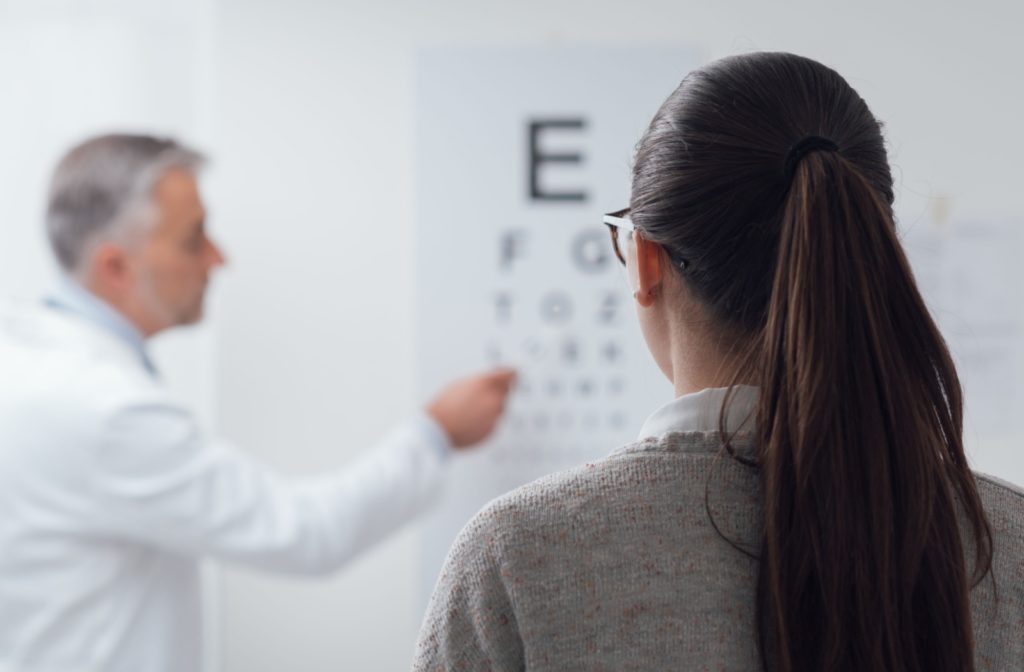Seeing our surroundings is one of the many ways we can connect with the world around us. Yet, not everyone experiences clear vision. Many people develop refractive errors like myopia (nearsightedness) and hyperopia (farsightedness) that result in blurry vision.
Myopia and hyperopia are two common refractive errors that affect distant and near vision respectively. While both result in blurry vision, they actually have different consequences on vision.
What is Myopia?
In our increasingly digital world, where most of us spend less time outdoors, myopia (nearsightedness) is on the rise. This refractive error causes distant objects to appear blurry while near objects remain clear.
The shape of the eye plays a key role in our ability to see clearly.
An eye with no refractive error is round, whereas an eye with myopia is typically elongated. For those with myopia, when the cornea refracts light as it enters the lens of the eye, these light rays converge and focus in front of the retina, rather than directly on it. This results in blurry and distorted distance vision.
Common symptoms of myopia include:
- Blurry vision when looking at distant objects
- Needing to squint to see clearly
- Headaches caused by eyestrain
- Difficulty seeing while driving, especially at night
- Frequent eye strain or fatigue
How Does Myopia Develop?
Myopia can develop at any age, but most commonly manifests during childhood. It typically develops from a combination of genetics and environmental influences.
Myopia tends to run in families. If one parent is nearsighted, a child is more likely to develop the condition.
Lifestyle factors play a significant role in the onset and progression of nearsightedness. In particular, studies show that children who spend more time outdoors are less likely to develop myopia.
Natural light exposure and looking at distant objects also helps maintain proper eye growth and reduces myopia progression. Conversely, activities that require close-up focus for extended periods make myopia more likely.
Environmental factors play a significant role in myopia development due to the fact that our eyes grow rapidly during infancy and childhood. This is why we often see noteworthy changes in our vision prescription during these years.
Risks of Unmanaged Myopia
While myopia is a common refractive error and isn’t necessarily a serious condition, leaving it unmanaged and uncorrected can lead to the development of high myopia.
High myopia is defined as a refractive error of -6.00 diopters or more. People with high myopia are at an increased risk of developing:
- Cataracts
- Glaucoma
- Retinal detachments or tears
- Myopic maculopathy
Myopia cannot be cured, but myopia can be managed in children to slow its progression using various control therapies. These therapies work by altering the eye’s focusing mechanism or reducing eye strain so the shape of the eye doesn’t continue to elongate.
What is Hyperopia?
Hyperopia (farsightedness), is a refractive error that causes nearby objects to appear blurry while those at a distance are seen clearly. While less common than myopia, hyperopia still impacts a large part of the population.
The shape of an eye with hyperopia is shorter from front to back compared to an eye with no refractive error. This reduced axial length means that light rays entering the eye are focused behind the retina, rather than directly on it, leading to blurry near vision.
Hyperopia often causes strain and discomfort when performing daily tasks that require seeing up close, such as reading or using a smartphone.
Symptoms of hyperopia generally include:
- Blurry vision when looking at close objects
- Eye strain or discomfort during prolonged reading or close-up work
- Headaches, particularly after close-up visual tasks
- Difficulty concentrating on tasks that require seeing up close
- Fatigue after tasks requiring near vision
- A tendency to squint to see clearly when focusing on nearby objects
How Does Hyperopia Develop?
Hyperopia primarily results from genetic and developmental factors. Unlike myopia, this refractive error is less influenced by lifestyle choices, although certain environmental factors during early childhood can play a role.
Like myopia, hyperopia tends to run in families. It’s often inherited and is present from birth. However, many children outgrow it as their eyes lengthen with age.
Children can often naturally compensate for mild amounts of hyperopia through accommodation, adjusting the lens inside their eye to maintain focus.
However, as accommodation decreases with age, adults are more likely to notice a decrease in near vision clarity, signaling the presence of presbyopia, also known as age-related farsightedness.
Risks of Unmanaged Hyperopia
Leaving hyperopia unmanaged isn’t typically as serious as myopia, but it can still lead to complications affecting daily life and visual health.
In children, uncorrected hyperopia increases the risk of developing amblyopia, otherwise known as lazy eye. This condition results when the brain favors one eye over the other.
In others, uncorrected hyperopia can lead to ongoing eyestrain and frequent headaches, affecting one’s ability to focus and reducing productivity.
Schedule an Appointment
Myopia and hyperopia are often considered stable, lifetime conditions. However, during childhood, when the eyes are still growing, these conditions are more likely to progress.
This is why monitoring visual changes during a routine eye exam is key for maintaining healthy vision and eye health. Because of ongoing developmental changes, we encourage children to have routine eye exams annually.Connect with our team at 2020 Eyecare Ohio to schedule an appointment for your routine eye exam.



